April 28, 2023
Air Date: April 28, 2023
FULL SHOW
SEGMENTS
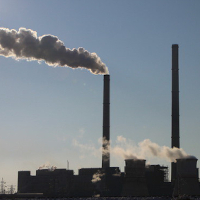
A New Clean Power Plan
View the page for this story
Under President Obama the Environmental Protection Agency tried to fight climate change by curbing overall emissions from the electric power sector, but those rules were blocked in court and then repealed by President Trump. Now the agency is trying again and it’s now backed up by provisions in the Inflation Reduction Act. Its new power plant emissions rules are crafted on a plant-by-plant basis designed to survive legal challenges, according to environmental law expert Pat Parenteau, who joins Host Steve Curwood to explain. (10:59)

Beyond the Headlines
/ Peter DykstraView the page for this story
This week, Living on Earth commentator Peter Dykstra joins Host Steve Curwood to share news of a lawsuit seeking to curb the use of aerial fire retardants to combat wildfires over water pollution concerns. They also shed light on the murder of Ecuadorian Indigenous activist Eduardo Mendúa, who opposed oil drilling in the Amazon. And they look back 70 years to the day Hooker Chemical Company sold off its Love Canal toxic chemical dumpsite for just one dollar, setting the scene for a public health crisis that came to light years later. (04:59)
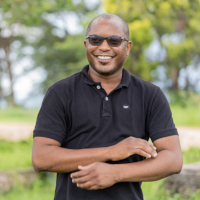
UK Courts Force A Zambian Copper Mine Cleanup
View the page for this story
The 2023 Africa recipient of the Goldman Environmental Prize brought a UK based mining company to justice for polluting a river in Zambia with waste from an open pit copper mine that sickened locals and killed fish. Prize winner Chilekwa Mumba joins Host Paloma Beltran to share how he organized the community and persuaded a UK based law firm to take on the case. (11:06)

BIRDNOTE®: The World's Most Abundant Bird
/ Michael SteinView the page for this story
The red-billed Quelea is a small finch-like African bird that migrates long distances in massive flocks. BirdNote®’s Michael Stein reports. (01:55)

Jellyfish Age Backwards: Nature's Secrets to Longevity
View the page for this story
In nature, some animals live far longer than humans, and some don’t appear to age at all. One species of jellyfish can continually revert back to a juvenile stage, making it essentially immortal. Author Nicklas Brendborg explores this and more in his new book, “Jellyfish Age Backwards: Nature’s Secrets to Longevity,” and he joins Host Paloma Beltran to share how humans can live longer. (17:28)
Show Credits and Funders
Show Transcript
230428 Transcript
HOSTS: Paloma Beltran, Steve Curwood
GUESTS: Nicklas Brendborg, Chilekwa Mumba, Pat Parenteau
REPORTERS: Peter Dykstra, Michael Stein
[THEME]
CURWOOD: From PRX – this is Living On Earth.
[THEME]
CURWOOD: I’m Steve Curwood.
BELTRAN: And I’m Paloma Beltran
Activists in Zambia take on an international mining company that was spilling toxic waste into a river.
MUMBA: So whenever those spillages would occur, would read in the media about how fish are just found floating. And as we found there were times when the acid levels of water was so high. So there were very specific complaints about stomach issues from children.
CURWOOD: Also, tips for living longer from other creatures.
BRENDBORG: Many humans live maybe between 70 and 90 years. But if we look out into nature, you can find animals like lobsters that don't age physically. And then animals like this jellyfish that my book is named after, Turritopsis, which can rejuvenate itself age backwards.
CURWOOD: That and more this week on Living on Earth – Stick Around!
[NEWSBREAK MUSIC: Boards Of Canada “Zoetrope” from “In A Beautiful Place Out In The Country” (Warp Records 2000)]
[THEME]
A New Clean Power Plan
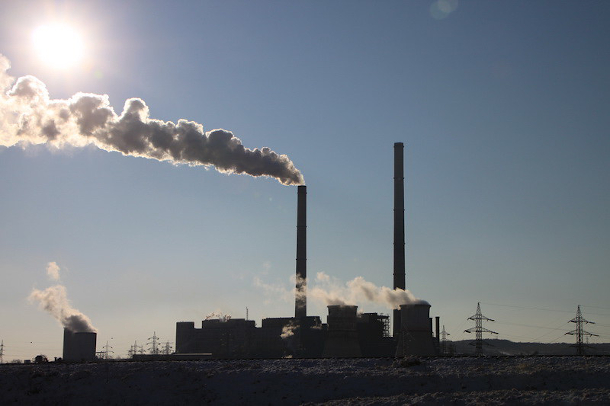
The Biden administration is putting forth new rules to curb greenhouse gas emissions from fossil fuel-fired power plants that will require carbon capture and sequestration in many instances. (Photo: Emilian Robert Vicol, Flickr, CC BY 2.0)
BELTRAN: From PRX and the Jennifer and Ted Stanley Studios at the University of Massachusetts Boston, this is Living on Earth. I’m Paloma Beltran.
CURWOOD: And I’m Steve Curwood.
You may remember President Obama tried to fight climate change with Clean Power Plan rules to impose limits on natural gas and coal fired power plants, only to get blocked in court and then repealed by President Trump. Now the Biden Administration wants to make natural gas and coal power plants more climate friendly with different rules that rely on carbon capture and storage, a technology that has yet to be proven as cost effective. Power plants emit around a quarter of total global warming gases in the US, and since there are only about a thousand of them, it’s simpler for them to pave the way to net zero emissions, compared to changing energy systems for millions of cars, homes, and businesses. But that doesn’t mean it’s going to be easy. The new clean power plan rules will likely face challenges in court. For more, let’s welcome back Pat Parenteau, former EPA regional counsel and emeritus professor at Vermont Law School. Hi there Pat!
PARENTEAU: Hi, Steve, good to be with you.
CURWOOD: Great to have you back. Now, we are still working on a lot of speculation as we record this segment. But more and more is emerging about these proposed new standards every day. And from what you're seeing, Pat, what are these rules going to shake out to, do you think?
PARENTEAU: Well, EPA is taking its cue from the Supreme Court's decision in West Virginia v. EPA last year, just about a year ago. So this is going to be a technology-based rule that will rely on carbon capture and sequestration, which will enable individual plants to meet an emission reduction standard, which is what the Supreme Court and Chief Justice Roberts' majority opinion said EPA should do in addressing greenhouse gas emissions from the power plant sector. So from my standpoint, EPA is doing exactly what it's been told to do by the Supreme Court.
CURWOOD: Pat, in what ways is this a successor to the 2015 Clean Power Plan that President Obama and his folks tried to implement?

These upcoming standards focus on carbon capture and storage projects for new and existing power plants. (Photo: Alberta Newsroom, Flickr, CC BY-NC-ND 2.0)
PARENTEAU: Yes, the Obama plan relied heavily on what's called 'generation shifting'. In other words, that law requires EPA to establish the best system of emission reduction. And the Obama plan said, the best system is one that doesn't rely on fossil fuels, both coal and gas, the best system is one that relies on renewable energy, solar and wind. So that was the strategy that the Obama administration pursued. It's rational. It's cost effective. It's reliable. But the Supreme Court said, it's not lawful, because Congress didn't give EPA explicit enough authority to make that kind of major change to the nation's energy mix. So EPA has gone back to what I call its wheelhouse authority, under the Clean Air Act, and that's going to require technology very similar, by the way, to the scrubbers that EPA has used to reduce other pollutants. Sulfur dioxide, nitrogen oxide, the things that cause acid rain, etc. That's what EPA has said. Alright, if you want us to rely on technology, it's going to be expensive, it's probably going to be more expensive than shifting to renewable sources of energy, which have become very cost competitive with fossil fuel energy sources. But if that's what the Supreme Court says, is the limit of our authority, that's what we'll do.
CURWOOD: So Pat, let me just be clear, what do you think are the chances of the Supreme Court of the United States killing this rule as well?
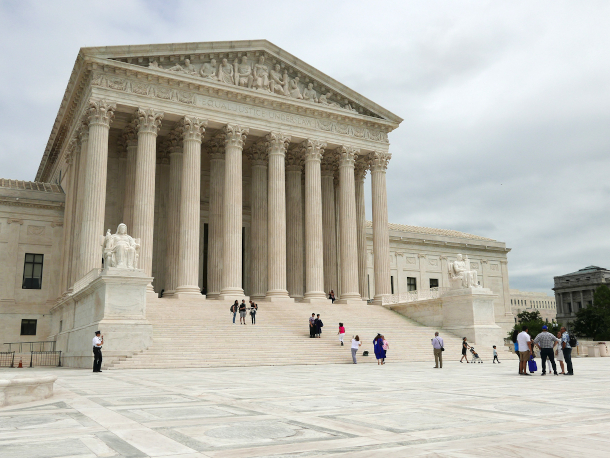
The Biden administration’s rules will be a response to the West Virginia v. EPA case, which was decided in 2022 and said that the agency effectively does not have the power to regulate the mix of generation sources to address carbon dioxide emissions from power plants. (Photo: Susan Melkisethian, Flickr, CC BY-NC-ND 2.0)
PARENTEAU: Well, the big question is going to be cost and whether or not in the language of the law, carbon capture and sequestration has been, quote, adequately demonstrated. Now, we know it's been demonstrated. In fact, the fossil fuel industry is touting carbon capture as the way to allow it to continue to generate electricity from using gas and coal. But the question is, is it commercially available? Is it affordable? Or is it going to cause individual plants, particularly older plants, to simply go out of business, because the cost of retrofitting these old plants with new carbon capture technology is so expensive. And the thing that we want to watch in EPA's rule when it's finally issued is how is EPA dealing with the cost question? And the timing question of which plants will have to install this technology and by what date and so forth? So lots of detail yet to be revealed to figure out how is all this going to come together in a way that will pass muster with the Supreme Court? There's no question, you know, Attorney General Morrissey of West Virginia, the one who won the earlier case striking Obama's clean power plant has already drawn up the papers to challenge the rule the minute it's final. So we know there's going to be a legal challenge. And there's a very good chance the Supreme Court will take it up. Not a guarantee that the court will review it, but a pretty good chance that it will review it. So EPA is preparing this rule as if it has to win five votes on the Supreme Court.
CURWOOD: So carbon capture and storage is not cost effective these days, Pat. Just how expensive is it compared to how it would protect the climate?
President Biden pledged that the power business will decarbonize by 2035. The EPA is preparing to unveil standards for new and existing power plants that will replace Trump's American Clean Energy rule and Obama's Clean Power Plan https://t.co/VztGKhvRNZ pic.twitter.com/2qZajQLPYm
— Reuters (@Reuters) April 24, 2023
PARENTEAU: Yeah, it's fiendishly expensive, it can increase the cost of plants by 40% or more. So the way that EPA is going to frame this rule, it's going to rely heavily on the Inflation Reduction Act, which created of course $370 billion worth of investment in clean energy technology. By the way, that money that EPA and the federal government is putting up is going to be matched, according to the financial analysts, by an even greater amount of private capital. You know, when you spend federal money, public money, you leverage that against private capital. So the inflation Reduction Act actually might be tripled according to some analyses, in terms of investment. And the more of that investment that's going into an actually targeted to carbon capture gives EPA a very strong argument that Congress has expressly authorized EPA to both rely on carbon capture as a technology and put money into developing the systems so that the utilities can afford it. In addition to that, there is a tax credit already on the books, and it allows up to $85 per ton of CO2 emissions if it's done through carbon capture. So what I'm saying is there are a great number of financial incentives that Congress has created to underwrite carbon capture technology for electricity generation. EPA's rule is going to fold that kind of incentive into the regulatory structure to get over the argument that it's not affordable.
CURWOOD: So let me see if I have the strategy correct now from the Biden administration. Respond to the Supreme Court and do it power plant by power plant, make the requirement that they capture the greenhouse gases that come from the power plant, and then facilitate the money for them to install the technology?
PARENTEAU: Yeah, it's exactly right. It's a carrot and stick approach. It's the most traditional approach to environmental policy that we've had since the early 1970s. You provide some economic incentives, through tax credits, through direct subsidies, and so forth. But then you also impose through regulation, performance standards that drive down the emissions causing climate change. And it's that combination, as I've said, that is EPA's traditional approach for now 50 years to dealing with these kinds of air pollution. And now, of course, global pollution problems. And to me, the Supreme Court ought to look at what EPA has done, and simply say, good job, you've followed our instruction. And you've done what we've told you could do, and bless it. But we'll have to wait and see if they will actually follow my advice on that.
CURWOOD: By the way, Pat, how does this fit into the political cycle? We're, what, on the scale of 20 months away from either a new term for President Biden or somebody else? To what extent can these rules get done in time to survive a change of administration? Or is it frankly, already too late?
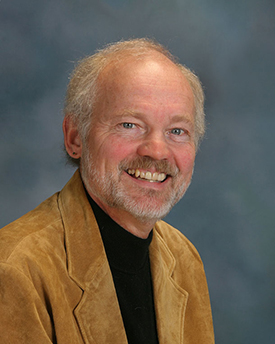
Pat Parenteau is emeritus professor of law at Vermont Law School and formerly served as EPA Regional Counsel. (Photo: Courtesy of Vermont Law School)
PARENTEAU: Now, that's a race, for sure. For new gas plants, the requirements apply automatically. Now, for coal fired power plants, and existing power plants, it's a different story. A lot of these coal plants are very old. In fact, you know, they're beyond in some respects, their normal, useful life. So one thing I will be looking for is how is EPA going to treat these dirty old coal plants. This is going to be a long, detailed rule and it will take a while I think, to figure out which plant has to actually install this carbon capture technology. And by what date. All of this is yet to be worked out. We were promised this rule, I mean, EPA announced that it would be out by the end of April. And now we're sort of reading that maybe it'll be May. So it'll come out as a proposed rule, there will have to be at least 60 days comment, and maybe more, and then it has to be finalized. And so now you're talking about getting this rule over the finish line and published in the Federal Register, you know, as fast as possible, because the Congressional Review Act is also going to be looming over this rule as that has over other rules so that if this rule isn't finalized, until next year, it's going to get caught in the Congressional Review Act, which means it's going to get caught in the election cycle that's coming up. So the faster that EPA can get this thing done, the better the chance that it might survive whatever is going to happen in the 2024 elections. And that's going to be a wildcard, obviously. A future administration, a future Congress could upset this once again, but you know, EPA can only do what it can control. So the sooner it can get this thing done, the better.
CURWOOD: Pat Parenteau is a former EPA regional counsel and emeritus professor at Vermont Law School. Pat, thanks so much for taking the time with us today.
PARENTEAU: My pleasure, Steve, thank you.
Related links:
- Reuters | “Biden EPA to Issue Power Plant Rules That Lean on Carbon Capture”
- Listen to our previous interview for a refresher on the case West Virginia v. EPA
[MUSIC: Arturo Sandoval, “Joy Spring” on Trumpet Evolution, Crescent Moon Records]
BELTRAN: Coming up – This year’s Goldman Prize winner from Africa took on a polluting copper mining company and won. Keep listening to Living on Earth.
ANNOUNCER: Support for Living on Earth comes from Sailors for the Sea and Oceana. Helping boaters race clean, sail green and protect the seas they love. More information @sailorsforthesea.org.
[CUTAWAY MUSIC: The Ahmad Jamal Trio, “The Awakening” on I Love Music, by Ahmad Jamal, The Verve Music Group]
Beyond the Headlines

Aerial fire retardants, which contain ammonium phosphate, are suspected by some as being harmful to waterways and wildlife. (Photo: scatteredVIEW, Flickr, CC BY-NC-ND 2.0)
BELTRAN: It’s Living on Earth, I’m Paloma Beltran.
CURWOOD: And Steve Curwood.
On the line out from Atlanta is Peter Dykstra. Peter's a commentator with Living on Earth and looks beyond the headlines for us from time to time. What do you have for us today, Peter?
DYKSTRA: Oh, hi, Steve. There's a lawsuit in federal court in Montana. The plaintiffs in this legal dispute want to curb the government's use, the US Forest Service, of aerial fire retardant to combat wildfires. The environmentalists who raised the concern are worried about waterways polluted by that sort of red stuff you see in any video footage of planes fighting big wildfires. But that red stuff includes ammonium phosphate, which can be a pollutant in waterways. There may be other toxic chemicals involved. But some of the opponents to stopping the use of aerial fire retardants include the people of a town like Paradise, California, or maybe it's a former town. Back in 2018, Paradise was wiped out and 85 people killed by a wildfire. They don't want to see more homes and more communities and more lives put at risk. But the bottom line here is that the plaintiffs say you'd be stopping one environmental problem by creating a new one.
CURWOOD: Yeah, I mean, this is what climate disruption has given us, right? Neither choice is really a great one. More fires, and therefore the concern and need to suppress them. And yet, we have so many toxic chemicals that we have put together, that we don't have a clean kit of things that we could use in this. Sort of one is the frying pan, the other is the fire, huh?
DYKSTRA: Ugly consequences on both sides.
CURWOOD: Hey, Peter, what else do you have for us this week?
DYKSTRA: Well Steve, you and I have talked over the years about the frequency of environmental activists being murdered in developing countries. Recently, Eduardo Mendúa, who was a leader among Ecuadorian indigenous tribes in opposing oil drilling in the Amazon took 12 bullets to the body. He left behind six children and his wife. And companies have been drilling farther and farther into the Amazon. Some of the indigenous tribes are in favor of that drilling, because it brings money into very poor communities. Others, the communities that Mendúa represented, want to see it stopped, because it's a direct threat to the way of life of these indigenous people in Ecuador.
Eduardo Mendúa, an Indigenous leader representing opposition to oil operations in his community in the Ecuadorian Amazon was murdered in February. Killings of Indigenous peoples defending their territory must end now!https://t.co/3fqFwjGdo4
— Amazon Watch (@amazonwatch) April 19, 2023
CURWOOD: Yeah Peter, this isn't an uncommon scenario. I mean, how many of these assassinations of environmental advocates in other parts of the world that we see each year?
DYKSTRA: Hundreds per year. In the United States, we often talk about harassment of environmentalists. It's legal harassment, or people losing their jobs. Things that are tame compared to rampant murder throughout the world. Per capita a country like Honduras has been a tragic leader in this field. But it tends to be happening more these days, with no end in sight.
CURWOOD: People who want to save the life of the forest, apparently all too often are giving up their own lives for that. Alright, let's take a look back now in the annals of history, Peter. What do you have for us this week?
DYKSTRA: We have a sorry 70th anniversary. On April 28, 1953, the Hooker Chemical company sold its Love Canal chemical dump site to the Niagara Falls Board of Education for $1. What nice guys. The deed included a waiver for any contamination that might be found at the site. Duh, it was a chemical dump site. And then Niagara Falls went ahead and built an elementary school on top of the waste site. They built another one six blocks away, and they built a community all around the Love Canal waste site. There were some serious health problems that came to light years later in the 1970s. The Love Canal tragedy came to national attention led by a housewife activist named Lois Gibbs. The entire area around Love Canal was evacuated by 1980. And it became a synonym, Love Canal, for toxic waste contamination all over America. And it led to the creation of the federal Superfund cleanup program.

Lois Gibbs, an activist mother from Niagara Falls, fought to evacuate families from the Love Canal chemical dumpsite in the 1970s. She is now the Director of the Center for Health, Environment, and Justice. (Photo: chesapeakeclimate, Flickr, CC BY-NC-ND 2.0)
CURWOOD: Right. That program was designed to not let companies who have contaminated something get off the hook just by selling it to somebody else.
DYKSTRA: For a dollar.
CURWOOD: Thanks, Peter. Peter Dykstra is a commentator with Living on Earth, and we'll talk to you again real soon.
DYKSTRA: All right, Steve, thanks a lot. Always good to talk to you.
CURWOOD: And there's more on the stories on the Living on Earth webpage. That's loe.org.
Related links:
- AP News | “Pollution Lawsuit Could Curb The Use Of Aerial Fire Retardant”
- Mongabay | “Indigenous Leader Assassinated Amid Conflict Over Oil That Divided Community”
- Wikimedia | “Hooker Electrochemical Company sells Love Canal to Niagara Falls Board of Education”
- Harvard T.H Chan School of Public Health | “Lois Gibbs, Executive Director of the Center for Health, Environment, and Justice”
[MUSIC: The Beatles, “In My Life” on Rubber Soul” (Remastered 2009) by Lennon and McCartney, Apple Records and Capitol Records]
UK Courts Force A Zambian Copper Mine Cleanup
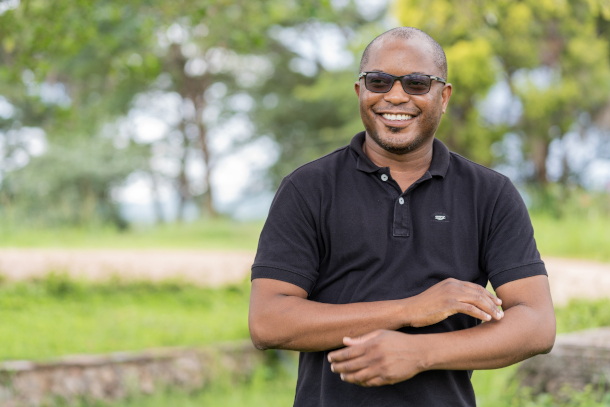
Chilekwa Mumba was recently awarded the prestigious Goldman Environmental Prize for coordinating the precedent-setting international lawsuit which held UK mining company Vedanta Resources responsible. (Photo: Goldman Environmental Foundation)
BELTRAN: The Goldman Environmental Prize annually awards 200,000 dollars to one environmental activist from each inhabited continent. Over the next few weeks we’ll share some of their stories with you starting this week with Chilekwa Mumba of Zambia. Mr. Mumba won the 2023 Goldman Prize for Africa for his work to stop the UK based mining company, Vedanta Resources, from polluting a local river. Mining is a big business in Zambia, roughly three quarters of the country’s exports are from mining. And the largest single employer in the country is the Konkola Copper Mines, which operates the second largest open pit mine in the world at 7 miles long. After mining began there the nearby Kafue River became so polluted, fish washed up on the banks of the river and the water turned bright blue from copper, sulfate and acid pollution. Local people became sick and could no longer fish. So, Chilekwa Mumba, who grew up in the area, began to organize local communities to fight back and secured an international law firm to take up the case, which won the right to sue the mining operation’s holding company in the UK. That ruling prompted the holding company to settle for an undisclosed amount, likely some place in the millions of dollars. The government of Zambia also replaced the mining company’s operators with new ones who have reportedly halted toxic spills and discharges. Chilekwa Mumba joins me now for more, welcome to Living on Earth!
MUMBA: Thanks very much for having me Paloma.
BELTRAN: What prompted you to organize a lawsuit against Konkola copper mines parent company Vedanta Resources.
MUMBA: Basically, there were incidents of pollution as the claimant stated. And even if the Zambian courts were involved in the process, nothing was really concluded reasonably with the claimants being the people who are being affected. So looking at that situation, and myself, being a resident of Chingola from the time I was young , though, so remembering how things were back then there was a specific point we used to go to to fish, and fish was no longer there. So it had this impact on my childhood memories. And from then on, I thought they should be something which should be done.
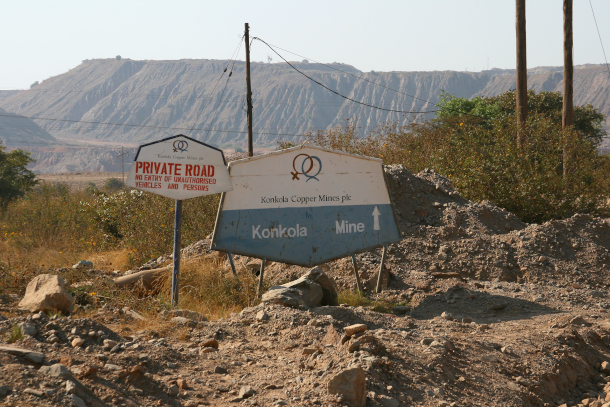
Alarmed by the pollution produced by the Konkola Copper Mines operation in Zambia, Chilekwa Mumba won a lawsuit in the UK that held the mine’s parent company, Vedanta Resources, responsible. (Photo: Goldman Environmental Foundation)
BELTRAN: How did the contamination of the Kafue River affect locals in Zambia? What is the importance of the Kafue River?
MUMBA: The Kafue River is the main water supply for farmers and residents not just in Chingola, but it flows all the way to the southern part of Zambia. So it is of great significance. And one of in fact, the tourist attractions, which we have in our country. So whenever those spillages would occur, would read in the media about how fish are just found floating. And obviously, there was some environmental degradation going on, as a result of the mining activities. As we found there were times when the acid levels of water was so high. So there were very specific complaints about stomach issues from children, children just really wander around the villages. And if they are thirsty, they don't think about what's happening, they'll just get a cup and take their drink of water from the river. That's how they live. So they'll usually get diseases. It's hard to quantify, but clearly the impact was there.
BELTRAN: In 2015, you convinced Leigh Day, a UK based law firm to visit and ultimately take on a lawsuit to hold on to legally accountable in the United Kingdom? How did you persuade this law firm to do this?
MUMBA: First of all, I was grasping for straws in the wind, I was just saying something has to be done about this. So I wrote to various law firms around that time. But it's important to state that I had already done an investigation and gathered whatever information I had. And I'll pass it on to the various law firms, maybe even close to 100 law firms, global law firms had written to and Leigh Day they just promptly replied, I think and they said, We're going to come over there in two weeks. And that's how the whole journey started.
BELTRAN: Wow. And what are some of the challenges you faced?
MUMBA: Well, one of the biggest challenges, just even professionally, was getting the community to believe that something could be done about the issue, you have to understand that the community is a typical village. And I'm afraid to say they do not have the best of education standards, which are required for somebody to realize their rights. So getting them to understand that it is possible to stand up for yourselves in using legal means it was a bit challenging, because they will they were like we've been complaining for years, nothing's ever happened even in our own courts. The case never reached a reasonable conclusion. But I found that we could get around that by myself spending more time in the community and building trust with the community and keeping them motivated to make sure that the whole case took off and keeping them United until we reached the conclusion.
BELTRAN: That was a huge endeavor. Because when you were building the case, you had to convince villagers to provide blood samples for analysis of the health impacts to look at the contamination in their body. And I believe we're talking about 1000s of blood samples.
MUMBA: Correct?
BELTRAN: How did you gain the trust of locals during this long process?
MUMBA: I spent a lot of time there. I was basically there. Every day, I would spend about three weeks a month there. At this point, my family was in Lusaka, but I had to kind of shift and be there for quite some time. In a typical village setting, you're prone to so many rumors, this and that. So it's very important that you maintain that face time with them and clarify rumors which come flying, left, right and center.
BELTRAN: What's the distance from the Capitol to where you had to travel and talk to the community that was involved in this lawsuit?
MUMBA: About 450 kilometers, and that takes about seven hours. It's a seven hour drive.
BELTRAN: That's a long drive.
MUMBA: Absolutely. Yeah.
BELTRAN: In 2017, you and a lawyer with Leigh Day were arrested at a public gathering while speaking with villagers about the lawsuit. Can you please tell us what happened that day? And what sort of harassment did you receive during the legal process?
MUMBA: Well, basically on that particular day, as you were saying, we were talking to a community and trying to get witness testimonies and so on and so forth. It was just basically part of our investigation process. And the police did come. And they used a certain law, I always refer to it as an archaic law where they say that you are supposed to notify them if you're in a gathering of more than 10 people, also. So now that law is not really applied all the time, it's just a matter of convenience when they feel like they need to, perhaps say harass someone, they'll effected, they came through and just picked us up saying we need to clarify some issues with you and picked us up and throw us into the police cells kept us there for some time, and eventually, it's a misdemeanor. So we were released by the end of the day.
BELTRAN: And in April of 2019, the UK Supreme Court found that Vedanta as a parent company of KCM, owed villagers near the mine a duty of care. And Vedanta could be held accountable in UK court for environmental damage from the in Konkola copper mines, operations, what was running through your head during the ruling?
MUMBA: I don't know how to really put that in words, it was a wonderful feeling for, for myself, the whole team, the lead a team, I don't know how to describe it's really.
BELTRAN: What was the local reaction to this victory?
MUMBA: It was, I mean, people are so happy, and not just those who are involved in the case itself. But just communities across the copper build, where there's a lot of mining, they have seen a form of protection for them, and the way mining operations do their industries and whatnot. It made them more aware of certain legal channels to pursue when something is wrong in the community.
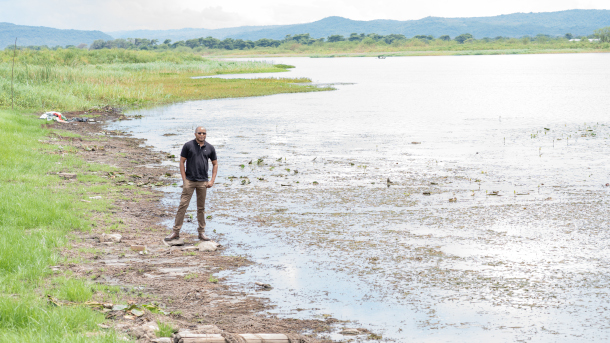
In 2021, Vedanta settled with nearly 2,000 people from the four villages near KCM; villagers received undisclosed financial compensation from Vedanta for the pollution that devastated their lives and environment. (Photo: Goldman Environmental Foundation)
BELTRAN: So what was the level of cooperation of the Vedanta copper mines through this process? What was their reaction after the case?
MUMBA: Well, they decided that they will be doing things in a much better way in terms of community care, and the environment. It is of great note that they found me to be a community interface, and have actually asked me to speak on behalf of the community on the issues around mining. And Vedanta has been quite responsive. They've been providing safe and clean water to different communities around mines. And interestingly, not just that particular mine, but other mines as well. They've responded quite well, they've been more responsive than ever.
BELTRAN: You were recently awarded the Goldman Environmental prize for your hard work and for this case, what does this award mean to you?
MUMBA: It has basically inspired me to do more for our communities. The first motivation for me was when I was a kid, I used to come here to fish, then that was the best thing to do playing outdoors. And then to find that situation. I have kids now and they've never experienced such fun is my opinion. It awoke something not just in my conscious, but just my whole being that perhaps we can take little steps and see how far they go.
BELTRAN: Chilekwa Mumba is a 2023 Goldman Prize recipient from Africa. Congratulations, and thank you so much for joining us.
MUMBA: Thank you
BELTRAN: And, Steve, I want to share one more thing about this case with you.
CURWOOD: Sure, what’s that?
BELTRAN: So, this case set a really important precedent in the UK. If you remember the Konkola Copper Mines is a subsidiary of the parent company Vedanta Resources.
CURWOOD: Yeah that’s right.
BELTRAN: So, this case is the first time that the UK Supreme Court has held a British parent company liable for the environmental damage caused by a subsidiary in a foreign country. And now the precedent has been set for more than 40,000 people in the Niger Delta who have sued for damages from oil spills that have contaminated their land and waters for years.
CURWOOD: And let me guess, they are suing the parent company of a local oil one.
BELTRAN: That’s right they are suing Shell Global, one of the biggest oil companies in the world and the UK Supreme Court gave them the green light to move forward with that case based on the outcome of Chilekwa Mumba’s work in Zambia.
CURWOOD: Well, oil drilling is a huge business in the Niger Delta, we’ll have to keep an eye on that case.
BELTRAN: Yes, indeed.
Related links:
- The Goldman Environmental Prize
- Business & Human Rights Resource Centre | “Vedanta & Konkola Copper Mines Settle UK Lawsuit Brought by Zambian Villagers for Alleged Pollution from Mining Activities”
- BBC News | “Vedanta Mine Settles Zambian Villagers' Pollution Claim”
[BIRDNOTE THEME]
BIRDNOTE®: The World's Most Abundant Bird
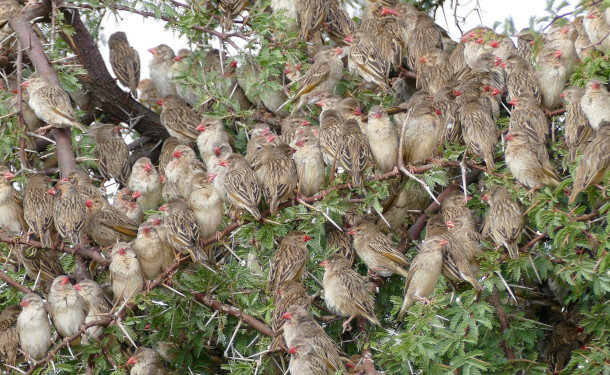
A flock of red-billed quelea perch in the branches of a tree. (Photo: Bernard Dupont, CC)
CURWOOD: The red-billed Quelea is a small finch-like African bird that migrates long distances in massive flocks. BirdNote’s Michael Stein has more.
BirdNote®
The World’s Most Abundant Bird
[Red-billed Quelea flock sounds, https://www.xeno-canto.org/389238 ]
In Africa, south of the Sahara, there’s a bird that roams the countryside in flocks—hordes, really—of two million or more. They fly in such tightly synchronized masses they can be mistaken at a distance for clouds of smoke.
[Red-billed Quelea flock sounds, https://www.xeno-canto.org/389238 ]
The birds are Red-billed Quelea. It’s estimated there are 1.5 billion of them — making them the most abundant of all wild birds.
[A few Red-billed Quelea singing, https://www.xeno-canto.org/373576 , 0.16-20 or more running behind narrative]
The sparrow-sized Red-billed Quelea, which is in the weaver family, has a stout, seed-cracking bill. The birds are mostly brown, but breeding males have red and black feathered heads.
Quelea nest in enormous colonies. A single tree may be hung with hundreds, even thousands, of carefully woven nests. Single colonies can cover hundreds of acres, totaling tens of millions of birds.
Unfortunately, their tastes include cultivated crops, like millet.
In fact, the increased planting of cereal crops over the last fifty years may have dramatically increased the number of quelea.
But setting aside their taste for crops, the sight of a couple million Red-billed Quelea swirling in unison and creating ever-changing patterns in the air is one of nature’s most amazing spectacles.
[flock sounds, https://macaulaylibrary.org/asset/88107]
###
Written by Bob Sundstrom
Producer: John Kessler
Managing Producer: Jason Saul
Associate Producer: Ellen Blackstone
© 2018 Tune In to Nature.org October 2018/2019 / March 2023
Narrator: Michael Stein
ID# REBIQU-01-2019-10-7 REBIQU-01
https://www.birdnote.org/listen/shows/worlds-most-abundant-bird
CURWOOD: For photos flock on over to the Living on Earth website, loe dot org.
Related link:
Learn more on the BirdNote® Website
[MUSIC: Concordia, “Piva” on Music for Mona Lisa, by J.A. Dalza, Metronome Records]
BELTRAN: Coming up – Looking to nature and flossing for the secrets of living a long life. That’s just ahead on Living on Earth.
ANNOUNCER: Support for Living on Earth comes from Friends of Smeagull the Seagull and Smeagull’s Guide to Wildlife. It’s all about the wildlife right next door to you! That’s Smeagull, S - M - E - A - G - U - L - L, SmeagullGuide.org.
[CUTAWAY MUSIC: Kenny Burrell, “Midnight Blue – Remastered” on Midnight Blue (The Rudy Van Gelder Edition), Blue Note Records]
Jellyfish Age Backwards: Nature's Secrets to Longevity
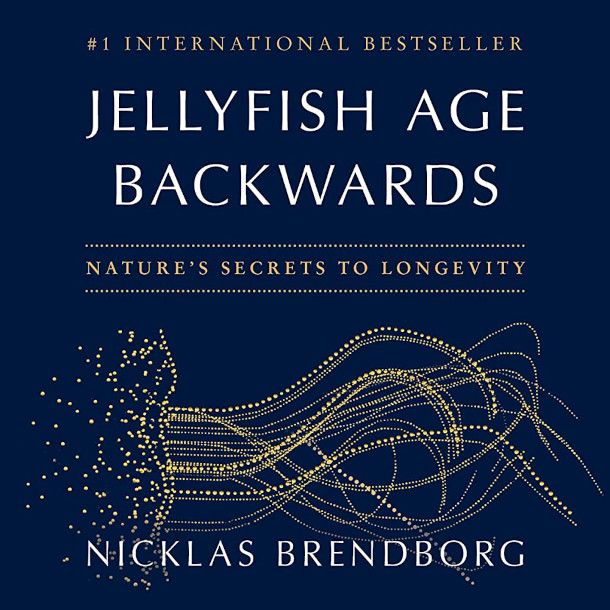
Jellyfish Age Backwards: Nature’s Secrets to Longevity is the new book by Nicklas Brendborg (Photo: Courtesy of Little, Brown and Company)
CURWOOD: It’s Living on Earth, I’m Steve Curwood
BELTRAN: And I’m Paloma Beltran.
The average human lifespan has increased dramatically with modern medicine and improved nutrition but in nature some animals live far longer than humans. And some don’t appear to age at all. The jellyfish turritopsis dhornii, that can continually revert back to a juvenile stage. In his new book “Jellyfish Age Backwards: Nature’s Secrets to Longevity”, Nicklas Brendborg explains what we can learn from animals about aging and how humans can live longer. He starts by explaining the title of his book.
BRENDBORG: My book title refers to a type of jellyfish called Turritopsis, which is this tiny jellyfish around the size of a fingernail, it has the ability to actually rejuvenate itself. So what actually happens is that you stress it somehow, for instance, by increasing the temperature in the water or increasing the salinity, or maybe starving the jellyfish a little. And then it can go from what is called the adult stage, so the stage that we know it from, back to something called the polyp stage. That would be akin to a butterfly turning back into a caterpillar. Then from there, the jellyfish can grow up anew, and then it can just go around in this cycle again and again and again. Of course, this jellyfish doesn't live forever out in nature where it lives in this big, big ocean, here it's gonna get eaten by something eventually. But at least in the laboratory no one has actually found a limit to how much you can make this jellyfish rejuvenate itself. So it's quite possible that as long as it had scientists to take care of it, you could actually make it live forever. So in principle, you can say it's an example of the holy grail of aging research, so that is an animal that can practically live forever, at least under human protection.
BELTRAN: So why does a human body age? We tend to think of aging as sort of this bad thing, but as you note in your book, biology all makes sense in the light of evolution. So does nature have a good reason?
Nicklas Brendborg is the author of Jellyfish Age Backwards: Nature’s Secrets to Longevity (Photo: Courtesy of Little, Brown and Company)
BRENDBORG: Yeah, so that's what you could call maybe the million dollar question: why do we age? For most organisms, it makes more sense to focus more on reproducing right now instead of, you know, having perfect upkeep of the body sometime in the future. So you can imagine if you are a mouse, even if you had like immortality, you wouldn't live forever, because you will get eaten by something anyways. So then it makes more sense to take the limited resources you have, put them into just having as many offspring as possible so that you get descendants. Then, of course, that will predict that an animal like humans, who will have a lot fewer predators and a lower risk of death from other causes as well, then we would have evolved longer lifespans, and that's what we see. But yeah, at this point, we know some of the stuff that goes wrong, but why this stuff goes wrong in the first place is still an open question.
BELTRAN: And you write about various organisms that don't age like humans, can you describe some of the studies in your book involving animals?
BRENDBORG: Yes, so the exciting thing about animal research, when it comes to aging, is that that's really the way where we can get a feel for what's possible, by looking out into nature. For instance, many humans live maybe between 70 and 90 years. But if we look out into nature, you can find another mammal, the bowhead whale, which lives more than 200 years, you can find one of its neighbors, actually, the Greenland shark, which can live around 400 years. And we even also know animals like lobsters that don't age physically. And then animals like this jellyfish that my book is named after, Turritopsis, which can rejuvenate itself, so age backwards.
BELTRAN: Does this mean that it's not necessary that humans age? Is there a reason to believe that we can learn how to combine abilities that stop other organisms from suffering from aging, and maybe use that for humans?
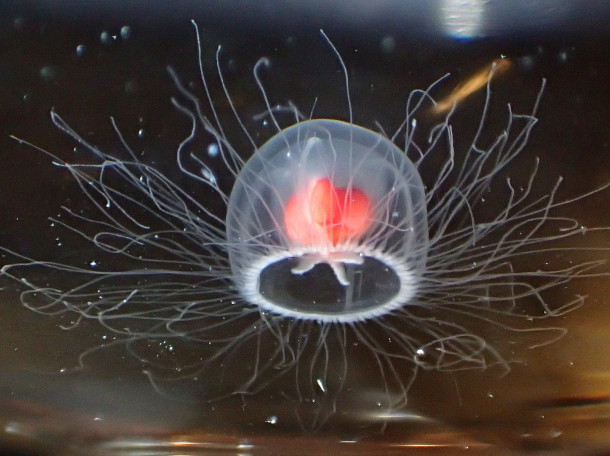
Turritopsis dohrnii, the jellyfish Nicklas Brendborg’s book is named for, can transform from its adult medusa form back to its polyp form. (Photo: Tony Wills, Wikimedia Commons, CC BY-SA 4.0)
BRENDBORG: We might describe aging as some sort of almost physical law where you just take a quick look and say, well, you know, we do see a lot of the same changes in an old mouse or an old dog or an old person, but it just, first of all, happens at wildly different speeds. So a mouse that's two or three years old, will have like gray hair, it has lost muscle mass and bone mass, and it's, you know, just gotten kind of slow, like people also get when we get old, but it just happens in a timespan when a human is still an infant. And then, if you look at humans, well, the time point when all of this stuff happens to us, a bowhead whale would still be young, or Greenland shark would still be young, and so on. So at least we can say that there might be a limit somewhere for how long a complex organism can live, but humans are just nowhere near it. So it seems that there's actually quite a lot more potential. And then we have these few species that then also suggest that, well, maybe it's possible to have a biological organism that doesn't age at all. So like the next step over.
BELTRAN: Tell us about the idea of hormesis and how it can be seen in our lifestyle, and our diet and in our surroundings.
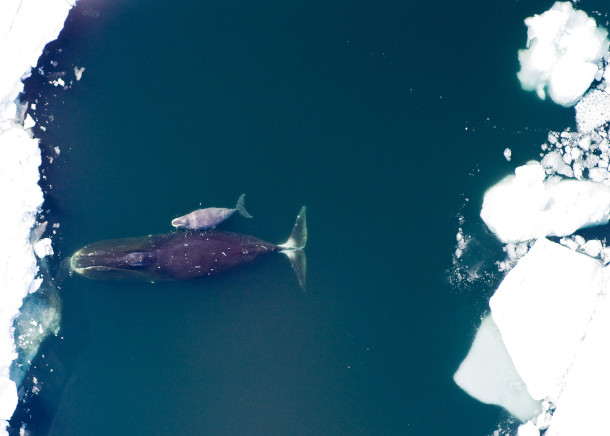
Bowhead whales can live for over 200 years (Photo: Bureau of Global Public Affairs, Flickr, CC BY-NC 2.0)
BRENDBORG: Hormesis is one of these phenomena that we have uncovered, you could say, by studying a lot of different ways to prolong life. Throughout time, researchers have just noticed that a lot of these life-extending treatments, they tend to have something in common and that is that they are actually kind of bad for you. So researchers have, for instance used radiation, like small doses of radiation, to extend the life of mice. They've used different kinds of toxin to extend the life of laboratory worms. And that is, of course, not because that these things are actually beneficial it's because they are a stress factor to the body. So of course, if you get a high dose of radiation, you get cancer and you die early, and get a high dose of toxins, you also die. But at a low level, the way this works is basically that the stress factor will turn on different processes in the body associated with repair, and like bodily upkeep, to combat the stress. And this can actually help then make you stronger in the long run. So hormesis could be understood as like the scientific version of 'what doesn't kill you makes you stronger'. And the best way to really understand it like from your own experience is this is basically what happens when you do exercise. So exercise is really, really good if you want to live a long life, if you want to be healthy in general, I think most people know that. But most people don't really know what it is about exercise that is so healthy, like you might think that it's while you're out for a run that you're really benefiting yourself. But if you think about what happens while you're out for a run, like you get a high pulse, you get a high blood pressure, your muscles and bones get damaged, your lungs are stressed, none of those things are healthy in isolation. So most of your organ systems actually stressed or taking damage, and that's, of course, also why your brain is trying to make you stop and telling you to just, you know, start walking and go home. That's because you are damaging yourself. But the magic really happens when you then stop running. Because then the body sees all of this damage and it basically interprets this as a kind of signal that says you need to get stronger. So it starts all these processes, as I said, involved in repair, in upkeep, in strengthening, so the next time you go for a run, then you have stronger muscles than before, and a stronger heart, and stronger bones, and stronger lungs.
BELTRAN: Yeah, so not all stress is bad...
BRENDBORG: Not all stress is bad, it's about the dose.
BELTRAN: And what about food? So we all know that eating more plant foods is good for us, having a green-rich diet, but that has to do a little bit also with hormesis, as you point out in your book. How does that work?
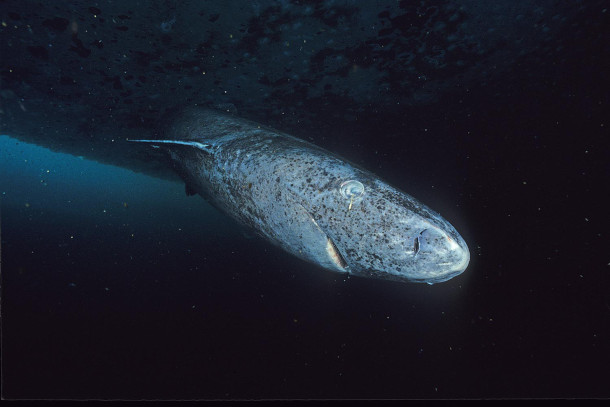
Greenland sharks can live for over 400 years (Photo: Hemming1952, Wikimedia Commons, CC BY-SA 4.0)
BRENDBORG: So there's all these fun studies coming out that you probably encountered where you, for instance, hear that the healthy part of blueberries is this one compound, or the healthy part of grapes is this other compound. And, you know, that might very well be true that some of the health benefits come from these compounds. But a lot of the times if you track what happens if you give to humans, they actually tend to, you know, go to the liver, the liver is involved in detoxification, that's why alcohol goes there. But like, really any, like, drug will go there as well, anything that the body needs to like, make safe and then clear out of the body. So a lot of these compounds do seem to be slightly toxic, actually. So, both that they go to the liver, they can also be harmful in high doses. And also from like a theoretical perspective, we know that just like you and I don't want to get eaten by something, that's actually the same thing for plants, they don't want to, you know, become dinner either. But we have all these abilities to run away or fight and hide, maybe. A plant is just sitting there so it can't do any of these things. So the way plants solve this problem is basically chemical warfare. So there's just an insane amount of plants that are toxic in some way or the other. So a lot of plants we would get like really sick or maybe even die from it. But even the plants that we do eat actually also tend to have various toxins maybe to protect against us, but maybe to protect against insects or other animals that could eat them. So then when when we know this theory of hormesis that could explain why, even if they are a little toxic, why is it so healthy to eat all these plants? Well, we get the same response where it's this slight stress response that then sets in motion all these bodily upkeep functions and then we end up stronger than if we exclude these low level toxins.
BELTRAN: Fascinating. And it's not just about subjecting ourselves to mild damage in order to grow back stronger. Something else you point out in your book is dental floss. And many of us are not regular with flossing. Why do you find that dental floss and flossing is so beneficial?

Exercising stresses your body which causes it to begin repair and strengthening processes, ultimately making you stronger and healthier (Photo: pxfuel)
BRENDBORG: Yeah, so I have a chapter called "Flossing for Longevity" and it is basically because the human body is not sterile in the sense that it's not free of bacteria, viruses, fungi and so on. It's actually teeming with all these microorganisms. And most of these microorganisms are neutral. They don't really affect us that much. They've found, you know, a nice warm place to live, where there's abundant food, and then they just take care of themselves. Then we have some that help us, for instance in the gut or they help with our immune system. But then we also have some that are harmful. And for some reason, a lot of the ones that get identified as harmful, they tend to, you know, originate in the mouth. So there's a certain bacteria in the mouth that keeps popping up inside the brains of people who died from Alzheimer's, dementia, but not in the brains of people who died from other causes. It keeps popping up inside the clot that forms when you have, say, a heart attack or a stroke. Then there's another bacteria from the mouth that keeps popping up in colon cancer and cancer of the pancreas. So there are these bacteria, that, you know, we find these weird places where they don't belong in connection with disease, then we also know that this infectious condition in the mouth called periodontitis, where you kind of have bacteria growth out of control, and this condition also increases the risk of all these different diseases. So I'm not saying that these bacteria are like the ultimate cause of these diseases, but it is very likely that they at least contribute to the diseases. But luckily, it's very easy to avoid, because bacteria have a simple way of life, they just take food and convert it into more bacteria. So if you want to lessen your bacterial burden in the mouth, you can have less food stuck, for instance, between your teeth, and then they have less to eat, and you decrease your risk of say, getting periodontitis, or just in general having these bacteria grow out of control. So the chapter is called "Flossing for Longevity," it, of course, also encompasses brushing your teeth, just generally keeping your mouth healthy, I guess would be the advice, and then you can, in like two minutes a day, really decrease your risk of all these different diseases.
BELTRAN: Yeah, better safe than sorry, right, in terms of bacteria in your mouth?
BRENDBORG: Exactly. And, you know, most health advice is, like, really hard to follow, say you have to exercise or have to eat really healthy and all that stuff. So I'm, of course, also always on the lookout for these things that are just simple, easy to do, and will benefit you. Because we of course, all want to do all the required amount of exercise and never eat, you know, stuff that we shouldn't or drink too much alcohol and so on. But it's just extra beneficial when we can find these small little things that can make a big difference.
BELTRAN: Yeah. What are other examples of maybe small little things like flossing your teeth, that can make a difference in your health and longevity?

Many plant foods, such as blueberries, have slightly toxic compounds in them that stimulate strengthening processes in your body (Photo: pxfuel)
BRENDBORG: I think, of course, we just quickly have to mention, you know, don't smoke, that's like the number one. If you are someone who is smoking and you only do one thing, just stop smoking. And it doesn't even matter what age you are, we can see that even people who are in, like, their seventies, and they stop smoking, you're not going to return to baseline, but you're at least going to, you know, increase your chance of getting more good years by stopping at any point. But besides that, I think that it's also very important to have a look on the like mental aspect of this. Because we know a lot about how influential our brain is to our physical health. And we can actually see that one of the factors that's most tightly associated with an early death is loneliness. So people that are lonely tend to have a high risk of many kinds of diseases, and also to die earlier. Also, people who have depression tend to have an increase in their brain aging, so their brain ages faster. And in general, if you ask these anthropologists that go to some of these long-lived communities and, you know, interview them and try to work out what's so different, they always come back and say that these are people that are extremely, first of all optimistic and tend to be kind of worry-free. And then they also tend to be very deeply committed to their community, so they have very strong social ties, and they have these strong feelings of meaning in their life, which doesn't have to be some crazy thing that they have a mission to earn a crazy amount of money or go all around the world, but mostly just like maybe they have a couple of grandkids and their mission is to help these kids thrive or to make sure their community is doing well or they're just always very, very sure of the fact that their life has a purpose. So there are these, you know, hard-to-tease-out ways that your mental health definitely affects your physical health.
BELTRAN: Yeah, and of course, one of the conclusions that you point out in the book is that people are different from each other. Literally what our bodies are made of and how we are programmed at the genetic level. That gives us different experiences with the same pathogens or treatments. For example, some people can digest milk while others can get diarrhea. So how do we approach finding what's right for us if we can't necessarily listen to general statements about what we do, or what we put in our bodies?

Flossing and keeping your mouth healthy prevents gum disease, but also may reduce your risk of Alzheimer’s disease, heart attack, stroke, and cancer (Photo: Marco Verch, Flickr, CC BY 2.0)
BRENDBORG: I mean, imagine if you're trying to figure out, is milk healthy or not? And then you have some of the study subjects and they're like, "oh, yeah, I love my milk," and you know, you can see it helps them grow taller, and all these health benefits. And then other people just feel sick every time they get it and just, you know, really benefit from removing it. And also, when you look at studies of big effects, they say, "oh, you know, if you eat spinach or something, your muscles will grow 20%." Well, if you look at, then, the different participants in that study, some of them might have 50% muscle growth, some of them might even have lost muscle. That's because you know, people are not the same. So, at the end of the day, of course, all these studies is the best way to get inspiration. But you have to also, you know, apply it on yourself, and then make sure whether it works as it's supposed to do or whether your body is different for a reason. We're gonna find the same thing later on as we dive deeper into genetics that, of course, sometimes if there's a dispute about what diet makes people feel better, well, both camps actually right because their bodies are just not the same. So we're already moving into this point of, you know, personalized medicine where if you, for instance, sequence the genome of a person, and that will be different for all of us, and then try to look, are there any things that you should be especially cautious about? So, are you likely to more quickly get, like, high cholesterol? So you have a higher risk of a heart attack, for instance. Have you got an increased risk of getting dementia? And all these things, so then you can maybe customize your health goals after that so that, you know, you hit the areas that are most likely to benefit you in particular.
BELTRAN: Nicklas Brendborg is the author of "Jellyfish Age Backwards: Nature's Secrets to Longevity." Thank you for joining us, Nicklas.
BRENDBORG: Thanks so much for having me.
Related links:
- Learn more about Nicklas Brendborg’s research on his website
- Find the book Jellyfish Age Backwards (Affiliate link helps donate to LOE and local indie bookstores)
[MUSIC: Biff Smith, “It Might As Well Be Spring” on Biff Smith Solo Piano, by Richard Rogers, self-published Biff Smith]
CURWOOD: Next time on Living on Earth, No Mow May and resisting the urge to clean up our yards for the month.
DEL TORO: May is actually a really important time for our pollinators that are just coming out of hibernation. So many of the species of bees that we have in the US are solitary bees that over-winter underground. And so the idea behind No-Mow May is to basically let our lawns grow out and provide some early season flowers for our pollinators that are coming out of hibernation to feed on.
CURWOOD: Overgrown lawns are a haven for our pollinators. That’s next week on Living on Earth.
[MUSIC: Biff Smith, “It Might As Well Be Spring” on Biff Smith Solo Piano, by Richard Rogers, self-published Biff Smith]
CURWOOD: Living on Earth is produced by the World Media Foundation. Our crew includes Fern Alling, Naomi Arenberg, Bobby Bascomb, Iris Chen, Josh Croom, Jenni Doering, Swayam Gagneja, Mark Kausch, Mark Seth Lender, Don Lyman, Jusneel Mahal, Louis Mallison, Aynsley O’Neill, Sophia Pandelidis, Jake Rego, El Wilson, and Jolanda Omari.
BELTRAN: Tom Tiger engineered our show. Alison Lirish Dean composed our themes. You can hear us anytime at L-O-E dot org, Apple Podcasts and Google Podcasts, and like us, please, on our Facebook page - Living on Earth. We tweet from @livingonearth. And find us on Instagram at livingonearthradio. And you can write to us at comments at loe dot org. I’m Paloma Beltran.
CURWOOD: And I’m Steve Curwood. Thanks for listening!
ANNOUNCER: Funding for Living on Earth comes from you, our listeners, and from the University of Massachusetts, Boston, in association with its School for the Environment, developing the next generation of environmental leaders. And from the Grantham Foundation for the protection of the environment, supporting strategic communications and collaboration in solving the world’s most pressing environmental problems.
ANNOUNCER 2: PRX.
Living on Earth wants to hear from you!
Living on Earth
62 Calef Highway, Suite 212
Lee, NH 03861
Telephone: 617-287-4121
E-mail: comments@loe.org
Newsletter [Click here]
Donate to Living on Earth!
Living on Earth is an independent media program and relies entirely on contributions from listeners and institutions supporting public service. Please donate now to preserve an independent environmental voice.
NewsletterLiving on Earth offers a weekly delivery of the show's rundown to your mailbox. Sign up for our newsletter today!
 Sailors For The Sea: Be the change you want to sea.
Sailors For The Sea: Be the change you want to sea.
 The Grantham Foundation for the Protection of the Environment: Committed to protecting and improving the health of the global environment.
The Grantham Foundation for the Protection of the Environment: Committed to protecting and improving the health of the global environment.
 Contribute to Living on Earth and receive, as our gift to you, an archival print of one of Mark Seth Lender's extraordinary wildlife photographs. Follow the link to see Mark's current collection of photographs.
Contribute to Living on Earth and receive, as our gift to you, an archival print of one of Mark Seth Lender's extraordinary wildlife photographs. Follow the link to see Mark's current collection of photographs.
 Buy a signed copy of Mark Seth Lender's book Smeagull the Seagull & support Living on Earth
Buy a signed copy of Mark Seth Lender's book Smeagull the Seagull & support Living on Earth

